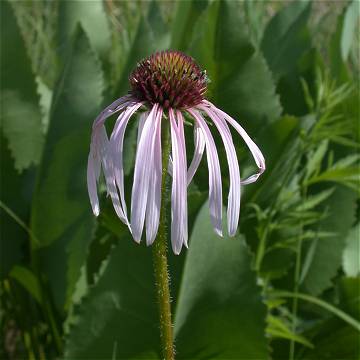

Echinacea pallida - (image 1 of 6)
Taxonomy
Family: Asteraceae
Habitat
Dry prairies and plains. Can tolerate dryer soil than E. purpurea.
Associates
Amorpha canescens, Andropogon gerardii, Comadra umbellata, Coreopsis palmata, Eryngium yuccifolium, Euphorbia corollata, Kuhnia eupatorioides, Petalostemum purpureum, Potentilla arguta, Ratibida pinnata, Silphium integrifolium, Silphium terebinthinaceum, Solidago rigida, Stipa spartea, Verbena stricta.
Distribution
Eastern MT south to TX, east to WI, IL, AR, and LA; irregularly and mostly introduced to MI.
Morphology
Erect perennial to 1 m. Leaf blades linear to narrowly lanceolate to elliptic, entire, at least 5 times longer than wide, parallel-veined. Flowers pale pink-purple; petals strongly reflexed.
Notes
Flowers late May to early August
Wetland indicator: Upland
Coneflowers are useful ornamental plants for dry soils in full sun.
References
Gleason, Henry A.
and A. Cronquist. 1991. Manual of Vascular Plants of Northeastern United States
and Adjacent Canada. Second Ed.
The New York Botanical Garden. Bronx, NY
Niering, W. A. 1979. The Audubon society field guide to North American
wildflowers: eastern region.
Knopf/Random House, New York.
Swink, F. and G. Wilhelm. 1994. Plants of the Chicago Region.
Indiana Academy of Science. The Morton Arboretum. Lisle, Illinois.
|
Michael Hough © 2004 |